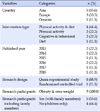Abstract
Purpose
This study aimed to identify the characteristics of an intervention program for school-aged overweight and obese children through an integrated literature review.
Methods
We used five databases (MEDLINE [PubMed], CINAHL, Embase, DBpia, and RISS) to search for studies published between January 1, 2013, and April 18, 2018. The studies were reviewed according to specific inclusion and exclusion criteria.
Results
Finally, nine studies were selected and classified into three types: school-based, community-based, and home-based. Specific intervention methods were identified, including exercise, diet, exercise and diet, and cognitive behavioral therapy.
Conclusion
Most studies have shown the effectiveness of obesity intervention programs. However, the variables, tools, and methods of measuring the effectiveness of intervention varied, making it difficult to compare the intervention studies. Therefore, future studies should develop objective and integrated measurement tools and evaluate the effects with long-term follow-up.
Figures and Tables
Appendix
Appendix
1. Cho IS, Ryu HS. The effect of community based participatory obesity management program in obese school children. J Oil Appl Sci. 2017 Dec;34(4):737–45. https://doi.org/10.12925/jkocs.2017.34.4.737
2. Sigmund E, Sigmundová D. Longitudinal 2-year follow-up on the effect of a non-randomised school-based physical activity intervention on reducing overweight and obesity of Czech children aged 10–12 years. Int J Environ Res Public Health. 2013 Aug 16;10(8):3667–83. https://doi.org/10.3390/ijerph10083667
3. Koo HC, Poh BK, Ruzita AT. Intervention on whole grain with healthy balanced diet to manage childhood obesity (GReat- Childtrial): study protocol for a quasi-experimental trial. Springer-Plus. 2016 Jun 22;5(1):840. https://doi.org/10.1186/s40064-016-2431-y
4. Guo H, Zeng X, Zhuang Q, Zheng Y, Chen S. Intervention of childhood and adolescents obesity in Shantou city. Obes Res Clin Pract. 2015 Jul-Aug;9(4):357–64. https://doi.org/10.1016/j.orcp.2014.11.006
5. Lee GY, Choi YJ. Effects of an obesity management mentoring program for Korean children. Appl Nurs Res. 2016 Aug;31: 160–4. https://doi.org/10.1016/j.apnr.2016.03.001
6. Rito AI, Carvalho MA, Ramos C, Breda J. Program obesity zero (POZ) - a community-based intervention to address overweight primary-school children from five Portuguese municipalities. Public Health Nutr. 2013 Jun;16(6):1043–151. https://doi.org/10.1017/s1368980013000244
7. Lee A, Ho M, Keung VM, Kwong AC. Childhood obesity management shifting from health care system to school system: intervention study of school-based weight management programme. BMC Public Health. 2014 Nov 3;14:1128. https://doi.org/10.1186/1471-2458-14-1128
8. Maddison R, Marsh S, Foley L, Epstein LH, Olds T, Dewes O, et al. Screen-time weight-loss intervention targeting children at home (SWITCH): a randomized controlled trial. Int J Behav Nutr Phys Act. 2014 Sep 10;11:111. https://doi.org/10.1186/s12966-014-0111-2
9.Wong EM, Cheng MM. Effects of motivational interviewing to promote weight loss in obese children. J Clin Nurs. 2013 Sep; 22(17–18):2519–30. https://doi.org/10.1111/jocn.12098
References
1. World Health Organization. 2008–2013 action plan for the global strategy for prevention and control of noncommunicable disease [Internet]. Geneva (Switzerland): World Health Organization;2008. cited 2018 Aprl 18. Available from: http://www.who.int/nmh/publications/ncd_action_plan_en.pdf.
2. Ministry of Education. 2016 nyeon hagsaeng geongang jeomgeom bogoseo [2016 School health examination sample survey results] [Internet]. Sejong (Korea): Ministry of Education;2017. 02. 21. cited 2018 Apr 30. Available from https://www.moe.go.kr/boardCnts/fileDown.do?m=020402&s=moe&fileSeq=2524cb8df965e5bc297eae34d7289ecf Korean.
3. Ministry of Health and Welfare. Gyeolgwa bogoseo [Result report] [Internet]. Record No. 29, 2017 gugmin geongang tonggye [The results from the Korean national health and nutrition examination survey 2017]. Sejong (Korea): Ministry of Health and Welfare;2019. 01. 11. cited 2019 Sep 22. Available from https://knhanes.cdc.go.kr/knhanes/sub04/sub04_03.do?classType=7.
4. Oh K, Jang MJ, Lee NY, Moon JS, Lee CG, Yoo MH, et al. Prevalence and trends in obesity among Korean children and adolescents in 1997 and 2005. Korean J Pediatr. 2008; 51(9):950–955.

5. Reilly JJ, Kelly J. Long-term impact of overweight and obesity in childhood and adolescence on morbidity and premature mortality in adulthood: Systematic review. Int J Obes (Lond). 2011; 07. 35(7):891–898. DOI: 10.1038/ijo.2010.222.

6. Woo MJ, Lee JY. The mediating effect of body image and the moderating effect of demographic data on psychosocial problems of obese children. Korea J Couns. 2007; 8(2):675–690. DOI: 10.15703/kjc.8.2.200706.675.

7. Sung KS, Yoon YM, Kim EJ. Meta-analysis of the effects of obesity management program for children. Child Health Nurs Res. 2013; 19(4):262–269. DOI: 10.4094/chnr.2013.19.4.262.

8. Park JY, Ma HH, Oh H. Trends in intervention study for childhood obesity in Korea. Child Health Nurs Res. 2017; 23(1):81–90. DOI: 10.4094/chnr.2017.23.1.81.

9. Heo EJ, Sim JE, Yoon EY. Systematic review on the study of the childhood and adolescent obesity in Korea: Dietary risk factors. Korean J Community Nutr. 2017; 22(3):191–206. DOI: 10.5720/kjcn.2017.22.3.191.

10. Jang JY, Bang KS. Health locus of control and health-promoting behaviors among Korean elementary school children. Korean Parent Child Health J. 2011; 06. 14(1):18–27.
11. Park KH. School and community-based intervention for prevention of childhood and adolescent obesity. J Korean Acad Fam Med. 2004; 25(7):519–526.
12. Whittemore R, Knafl K. The integrative review: updated methodology. J Adv Nurs. 2005; 52(5):546–553. DOI: 10.1111/j.1365-2648.2005.03621.x.

13. Garrard J. Health sciences literature review made easy: the matrix method. 5th ed. Burlington (MA): Jones & Bartlett Learning;2016. p. 240.
14. Lee JH, Oh S. Effects of the 26-weeks obesity management program on obesity index, self-esteem, self-efficacy, and body image among obese elementary school children. J Korea Acad Ind Co-op Soc. 2016; 17(9):83–93. DOI: 10.5762/KAIS.2016.17.9.83.





 PDF
PDF ePub
ePub Citation
Citation Print
Print






 XML Download
XML Download